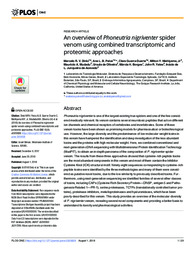An overview of Phoneutria nigriventer spider venom using combined transcriptomic and proteomic approaches.
An overview of Phoneutria nigriventer spider venom using combined transcriptomic and proteomic approaches.
Autoria: DINIZ, M. R. V.; PAIVA, A. L. B.; GUERRA-DUARTE, C.; NISHIYAMA JÚNIOR, M. Y.; MUDADU, M. de A.; OLIVEIRA, U. de; BORGES, M. H.; YATES, J. R.; JUNQUEIRA-DE-AZEVEDO, I. de
Resumo: Abstract. Phoneutria nigriventer is one of the largest existing true spiders and one of the few considered medically relevant. Its venom contains several neurotoxic peptides that act on different ion channels and chemical receptors of vertebrates and invertebrates. Some of these venom toxins have been shown as promising models for pharmaceutical or biotechnological use. However, the large diversity and the predominance of low molecular weight toxins in this venom have hampered the identification and deep investigation of the less abundant toxins and the proteins with high molecular weight. Here, we combined conventional and next-generation cDNA sequencing with Multidimensional Protein Identification Technology (MudPIT), to obtain an in-depth panorama of the composition of P. nigriventer spider venom. The results from these three approaches showed that cysteine-rich peptide toxins are the most abundant components in this venom and most of them contain the Inhibitor Cysteine Knot (ICK) structural motif. Ninety-eight sequences corresponding to cysteine-rich peptide toxins were identified by the three methodologies and many of them were considered as putative novel toxins, due to the low similarity to previously described toxins. Furthermore, using next-generation sequencing we identified families of several other classes of toxins, including CAPs (Cysteine Rich Secretory ProteinÐCRiSP, antigen 5 and Pathogenesis-Related 1ÐPR-1), serine proteinases, TCTPs (translationally controlled tumor proteins), proteinase inhibitors, metalloproteinases and hyaluronidases, which have been poorly described for this venom. This study provides an overview of the molecular diversity of P. nigriventer venom, revealing several novel components and providing a better basis to understand its toxicity and pharmacological activities.
Ano de publicação: 2018
Tipo de publicação: Artigo de periódico
Unidade: Embrapa Agricultura Digital
Palavras-chave: Phoneutria nigriventer, Proteomics, Proteômica, Transcriptoma, Transcriptomics
Observações
1 - Por padrão são exibidas publicações dos últimos 20 anos. Para encontrar publicações mais antigas, configure o filtro ano de publicação, colocando o ano a partir do qual você deseja encontrar publicações. O filtro está na coluna da esquerda na busca acima.
2 - Para ler algumas publicações da Embrapa (apenas as que estão em formato ePub), é necessário ter, no celular ou computador, um desses softwares gratuitos. Sistemas Android: Google Play Livros; IOS: iBooks; Windows e Linux: software Calibre.
Acesse outras publicações
Acesse a Base de Dados da Pesquisa Agropecuária (BDPA) para consultar o acervo completo das bibliotecas da Embrapa.

